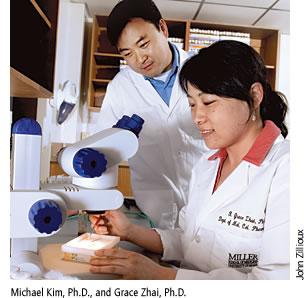 A fruit fly the size of a sesame seed can provide scientists a glimpse into some of the most complex diseases in humans. This is because most of the genes in fruit flies, or Drosophila, are homologous to human genes, and the fly’s two-month life span allows researchers to watch the progression from birth to death in high speed. A fruit fly the size of a sesame seed can provide scientists a glimpse into some of the most complex diseases in humans. This is because most of the genes in fruit flies, or Drosophila, are homologous to human genes, and the fly’s two-month life span allows researchers to watch the progression from birth to death in high speed.
Like worms and yeast, fruit flies provide researchers with a simple model system that can be used to study everything from Parkinson’s disease to the effects of new pharmaceuticals.
Grace Zhai, Ph.D., assistant professor of molecular and cellular pharmacology, was recruited in 2006 as the Miller School’s first “fly person” (as scientists studying Drosophila often call themselves). She made the road trip from her former post at Baylor College of Medicine in Texas to Miami with nearly half a million fruit flies in tow, organized meticulously in vials labeled with 1,000 different gene mutations.
Zhai uses Drosophila to investigate the possible causes and effects of neurodegenerative diseases like Alzheimer’s, while assistant professor Michael Kim, Ph.D., who joined Zhai six months after she had established her lab, studies neurodevelopmental diseases. “We’re trying to understand the mechanisms of degeneration and whether we can find any protective factors that can slow down or reverse the degeneration process,” says Zhai.
To do this, Zhai and Kim create mutant flies. They introduce DNA carrying a mutation associated with the disease they are studying into the fruit fly’s chromosome, creating a transgenic fly strain that carries the human mutation. In her studies of Alzheimer’s, Zhai first observes the mutant fly’s coordination, and then dissects its brain to look for signs or phenotypes of degeneration similar to those in a human brain.
Kim’s studies are currently focused mostly on motor neuron development. “To put it in perspective, the mammalian spinal cord is composed of tens of thousands of motor neurons, whereas in a fly, there are essentially less than a thousand,” he says. “Using the fly system, we can discover some of the genetic factors that are essential for neurodevelopment and potentially related to human motor disorders.” |


